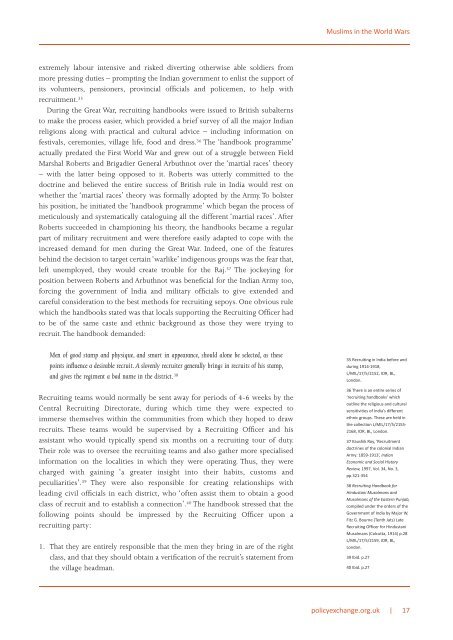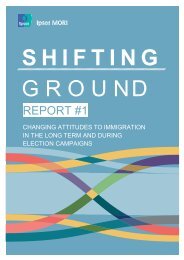You also want an ePaper? Increase the reach of your titles
YUMPU automatically turns print PDFs into web optimized ePapers that Google loves.
extremely labour intensive and risked diverting otherwise able soldiers from<br />
more pressing du<strong>ties</strong> – prompting the Indian government to enlist the support of<br />
its volunteers, pensioners, provincial officials and policemen, to help with<br />
recruitment. 35<br />
During the Great War, recruiting handbooks were issued to British subalterns<br />
to make the process easier, which provided a brief survey of all the major Indian<br />
religions along with practical and cultural advice – including information on<br />
festivals, ceremonies, village life, food and dress. 36 The ‘handbook programme’<br />
actually predated the First World War and grew out of a struggle between Field<br />
Marshal Roberts and Brigadier General Arbuthnot over the ‘martial races’ theory<br />
– with the latter being opposed to it. Roberts was utterly committed to the<br />
doctrine and believed the entire success of British rule in India would rest on<br />
whether the ‘martial races’ theory was formally adopted by the Army. To bolster<br />
his position, he initiated the ‘handbook programme’ which began the process of<br />
meticulously and systematically cataloguing all the different ‘martial races’. After<br />
Roberts succeeded in championing his theory, the handbooks became a regular<br />
part of military recruitment and were therefore easily adapted to cope with the<br />
increased demand for men during the Great War. Indeed, one of the features<br />
behind the decision to target certain ‘warlike’ indigenous groups was the fear <strong>that</strong>,<br />
left unemployed, they would create trouble for the Raj. 37 The jockeying for<br />
position between Roberts and Arbuthnot was beneficial for the Indian Army too,<br />
forcing the government of India and military officials to give extended and<br />
careful consideration to the best methods for recruiting <strong>sep</strong>oys. One obvious rule<br />
which the handbooks stated was <strong>that</strong> locals supporting the Recruiting Officer had<br />
to be of the same caste and ethnic background as those they were trying to<br />
recruit. The handbook demanded:<br />
Men of good stamp and physique, and smart in appearance, should alone be selected, as these<br />
points influence a desirable recruit. A slovenly recruiter generally brings in recruits of his stamp,<br />
and gives the regiment a bad name in the district. 38<br />
Recruiting teams would normally be sent away for periods of 4-6 weeks by the<br />
Central Recruiting Directorate, during which time they were expected to<br />
immerse themselves within the communi<strong>ties</strong> from which they hoped to draw<br />
recruits. These teams would be supervised by a Recruiting Officer and his<br />
assistant who would typically spend six months on a recruiting tour of duty.<br />
Their role was to oversee the recruiting teams and also gather more specialised<br />
information on the locali<strong>ties</strong> in which they were operating. Thus, they were<br />
charged with gaining ‘a greater insight into their habits, customs and<br />
peculiari<strong>ties</strong>’. 39 They were also responsible for creating relationships with<br />
leading civil officials in each district, who ‘often assist them to obtain a good<br />
class of recruit and to establish a connection’. 40 The handbook stressed <strong>that</strong> the<br />
following points should be impressed by the Recruiting Officer upon a<br />
recruiting party:<br />
1. That they are entirely responsible <strong>that</strong> the men they bring in are of the right<br />
class, and <strong>that</strong> they should obtain a verification of the recruit’s statement from<br />
the village headman.<br />
Muslims in the World Wars<br />
35 Recruiting in India before and<br />
during 1914-1918,<br />
L/MIL/17/5/2152, IOR, BL,<br />
London.<br />
36 There is an entire series of<br />
‘recruiting handbooks’ which<br />
outline the religious and cultural<br />
sensitivi<strong>ties</strong> of India’s different<br />
ethnic groups. These are held in<br />
the collection L/MIL/17/5/2155-<br />
2168, IOR, BL, London.<br />
37 Kaushik Roy, ‘Recruitment<br />
doctrines of the colonial Indian<br />
Army: 1859-1913’, Indian<br />
Economic and Social History<br />
Review, 1997, Vol. 34, No. 3,<br />
pp.321-354<br />
38 Recruiting Handbook for<br />
Hindustani Musalmans and<br />
Musalmans of the Eastern Punjab,<br />
compiled under the orders of the<br />
Government of India by Major W.<br />
Fitz G. Bourne (Tenth Jats) Late<br />
Recruiting Officer for Hindustani<br />
Musalmans (Calcutta, 1914) p.28<br />
L/MIL/17/5/2159, IOR, BL,<br />
London.<br />
39 Ibid. p.27<br />
40 Ibid. p.27<br />
policyexchange.org.uk | 17



